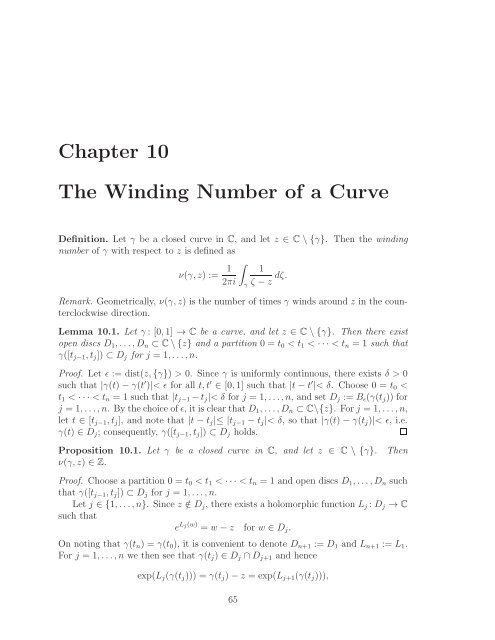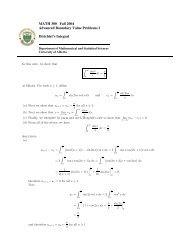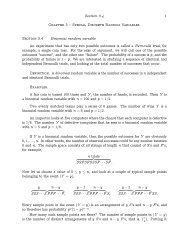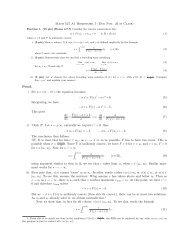Math 411: Honours Complex Variables - University of Alberta
Math 411: Honours Complex Variables - University of Alberta
Math 411: Honours Complex Variables - University of Alberta
Create successful ePaper yourself
Turn your PDF publications into a flip-book with our unique Google optimized e-Paper software.
Chapter 10<br />
The Winding Number <strong>of</strong> a Curve<br />
Definition. Let γ be a closed curve in C, and let z ∈ C \ {γ}. Then the winding<br />
number <strong>of</strong> γ with respect to z is defined as<br />
ν(γ,z) := 1<br />
�<br />
1<br />
2πi ζ −z dζ.<br />
Remark. Geometrically, ν(γ,z) is the number <strong>of</strong> times γ winds around z in the counterclockwise<br />
direction.<br />
Lemma 10.1. Let γ: [0,1] → C be a curve, and let z ∈ C \{γ}. Then there exist<br />
open discs D1,...,Dn ⊂ C\{z} and a partition 0 = t0 < t1 < ··· < tn = 1 such that<br />
γ([tj−1,tj]) ⊂ Dj for j = 1,...,n.<br />
Pro<strong>of</strong>. Let ǫ := dist(z,{γ}) > 0. Since γ is uniformly continuous, there exists δ > 0<br />
such that |γ(t)−γ(t ′ )|< ǫ for all t,t ′ ∈ [0,1] such that |t−t ′ |< δ. Choose 0 = t0 <<br />
t1 < ··· < tn = 1 such that |tj−1−tj|< δ for j = 1,...,n, and set Dj := Bǫ(γ(tj)) for<br />
j = 1,...,n. Bythechoice <strong>of</strong>ǫ, itisclearthatD1,...,Dn ⊂ C\{z}. Forj = 1,...,n,<br />
let t ∈ [tj−1,tj], and note that |t−tj|≤ |tj−1 −tj|< δ, so that |γ(t)−γ(tj)|< ǫ, i.e.<br />
γ(t) ∈ Dj; consequently, γ([tj−1,tj]) ⊂ Dj holds.<br />
Proposition 10.1. Let γ be a closed curve in C, and let z ∈ C \ {γ}. Then<br />
ν(γ,z) ∈ Z.<br />
Pro<strong>of</strong>. Choose a partition 0 = t0 < t1 < ··· < tn = 1 and open discs D1,...,Dn such<br />
that γ([tj−1,tj]) ⊂ Dj for j = 1,...,n.<br />
Let j ∈ {1,...,n}. Since z /∈ Dj, there exists a holomorphic function Lj: Dj → C<br />
such that<br />
e Lj(w) = w−z for w ∈ Dj.<br />
On noting that γ(tn) = γ(t0), it is convenient to denote Dn+1 := D1 and Ln+1 := L1.<br />
For j = 1,...,n we then see that γ(tj) ∈ Dj ∩Dj+1 and hence<br />
exp(Lj(γ(tj))) = γ(tj)−z = exp(Lj+1(γ(tj))),<br />
65<br />
γ







